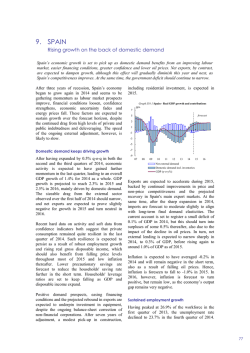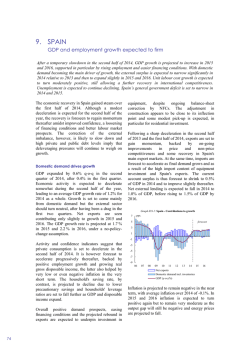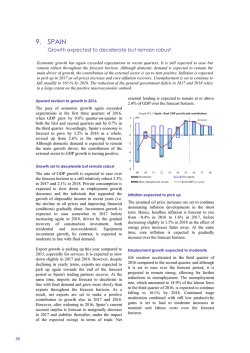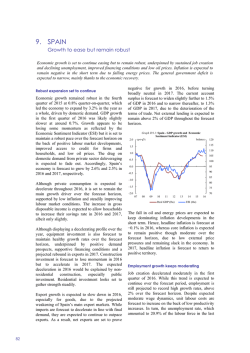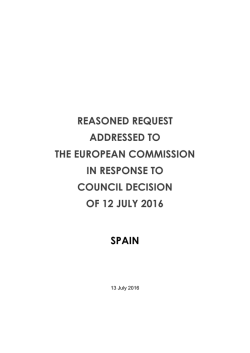
5200 final COMMISSION RECOMMENDATION of 9.3
EUROPEAN COMMISSION Brussels, 9.3.2016 C(2016) 5200 final COMMISSION RECOMMENDATION of 9.3.2016 regarding measures to be taken by Spain in order to ensure a timely correction of its excessive deficit EN EN COMMISSION RECOMMENDATION of 9.3.2016 regarding measures to be taken by Spain in order to ensure a timely correction of its excessive deficit THE EUROPEAN COMMISSION, Having regard to the Treaty on the Functioning of the European Union, Having regard to Regulation (EU) No 473/2013 of the European Parliament and of the Council of 21 May 2013 on common provisions for monitoring and assessing draft budgetary plans and ensuring the correction of excessive deficit of the Member States in the euro area1, and in particular Article 11(2) thereof, Whereas: (1) According to Article 126 of the Treaty on the Functioning of the European Union (TFEU), Member States shall avoid excessive government deficits. (2) The Stability and Growth Pact is based on the objective of sound government finances as a means of strengthening the conditions for price stability and for strong sustainable growth conducive to employment creation. (3) On 27 April 2009, the Council decided, in accordance with Article 104(6) TEC [now Article 126(6) TFEU], that an excessive deficit existed in Spain. On 21 June 2013, in accordance with Article 126(7) TFEU, the Council extended the deadline for correcting the excessive deficit to 2016, as Spain had taken effective action but adverse economic events with major implications on public finances had occurred2. In order to bring the general government deficit below the 3% of GDP reference value by 2016, Spain was recommended to reach a general government deficit target of 6.5% of GDP in 2013, 5.8% of GDP in 2014, 4.2% of GDP in 2015, and 2.8% of GDP in 2016. Based on the Commission 2013 spring forecast extended to 2016, this was deemed consistent with an improvement in the structural balance of 1.1%, 0.8%, 0.8%, and 1.2% of GDP in years 2013-2016, respectively. To achieve this improvement, Spain was called on to take additional fiscal policy measures of 2%, 1% and 1.5% of GDP in 2014, 2015 and 2016, respectively. On 15 November 2013, following the 1 October 2013 deadline for taking effective action foreseen in the recommendation, the Commission assessed the budgetary situation and, in particular, the action taken in compliance with the Council's recommendations. As it was considered that Spain had taken effective action, the Excessive Deficit Procedure has therefore been held in abeyance since then. (4) On 12 October 2015, the Commission delivered its Opinion on Spain's 2016 draft budgetary plan, which was submitted on 11 September 2015, ahead of the deadline of 1 OJ L 140, 27.5.2013, p. 11. All documents related to the excessive deficit procedure of Spain can be found at: http://ec.europa.eu/economy_finance/economic_governance/sgp/deficit/countries/spain_en.htm 2 EN 2 EN 15 October set in Article 6 of Regulation (EU) No 473/20133. Due to its early submission, related to the timing of Spain's parliamentary elections, the draft budgetary plan incorporated the central government budget that was adopted by the government on 31 July 2015, but did not include up-to-date and fully specified measures for regional governments. The Commission, in its opinion on Spain's 2016 draft budgetary plan, concluded that the plan was at risk of non-compliance with the provisions of the Stability and Growth Pact. The Commission therefore invited the Spanish authorities to submit an updated draft budgetary plan, including fully specified and up-to-date regional measures, as soon as possible. EN (5) According to the 2015 autumn EDP notification, the deficit in 2014 was at 5.9% of GDP (marginally higher than reported in spring due to a downward revision of nominal GDP), 0.1% of GDP above the EDP target. The Commission 2016 winter forecast projects the general government deficit to have reached 4.8% of GDP in 2015, above the recommended deficit target of 4.2% of GDP. The reduction of the deficit was held back by the budgetary impact of the reform of the personal income tax. Furthermore, windfall revenues from other taxes were more than offset by higher expenditure. According to the Commission 2016 winter forecast, the general government deficit is forecast to narrow to 3.6% of GDP in 2016, above the 3% of GDP reference value of the Treaty and the recommended deficit target of 2.8% of GDP. There are thus risks to the timely correction of the excessive deficit. (6) The foreseen reduction of the general government deficit over 2015-2016 largely relies on the cyclical recovery of the economy and the downward trend in interest expenditure in a low interest rate environment. Risks to the Commission 2016 winter forecast budgetary outlook consist mainly of uncertainties regarding expenditure control, in particular at regional level. This is in view of considerable expenditure growth in the second half of 2015 and the low expected budgetary impact of planned consolidation measures on the expenditure side, especially at regional and local level in 2016. (7) In 2015, the general government gross debt-to-GDP ratio is expected to be close to 100% and, based on the Commission 2016 winter forecast, it is projected to remain around this level in 2016, as well as in 2017 (on a no-policy-change basis). (8) Based on the Commission 2016 winter forecast, the cumulative change in the structural balance over 2013-2015 amounts to 0.8% of GDP, clearly below the effort recommended by the Council (2.7% of GDP over 2013-2015). Corrected for revisions to potential GDP growth estimates and revenue shortfalls, the change in the structural balance amounts to -0.2% of GDP over 2013-2015, also falling short of the recommended structural effort. Furthermore, Spain is not expected to have met the required fiscal effort based on the bottom-up method over 2013-2015. In 2016, the unadjusted structural balance is forecast to remain unchanged, while the adjusted balance is expected to deteriorate by 0.2% of GDP. Hence, both the unadjusted and adjusted changes in the structural balance are expected to fall short of what was recommended by the Council. Also based on the bottom-up method, no fiscal effort is projected to be delivered by Spain in 2016, which would imply falling significantly short of the 1.5% of GDP effort deemed necessary to achieve the target. 3 C(2015) 6892 final. 3 EN EN (9) The projected deficit above the 3% of GDP reference value in 2016 according to the Commission 2016 winter forecast points to a risk of non-compliance with the deadline to correct the excessive deficit. (10) Since 2012, Spain's Stability law has been strengthened in order to, among other things, ensure compliance by the sub-sectors of general government with their respective deficit, debt and expenditure targets. Despite this, only one of 13 adjustment plans by regional governments that did not reach their deficit targets in 2014 was officially adopted by the competent Financial and Fiscal Policy Council, thus preventing their monitoring by the Ministry of Finance. According to the latest available data (November 2015)4 the aggregate regional government deficit stood at 1.3% of GDP. This is above the 0.7% deficit objective for 2015, thus pointing to a risk of a non-negligible deviation from the target by year-end. However, no preventive (nor corrective) measures set out in Spain's Stability law have been applied by the Ministry of Finance to regions at risk of non-compliance with the 2015 fiscal targets. (11) Regulation (EU) No 473/2013 complements the Stability and Growth Pact with an enhanced coordination and surveillance framework for budgetary policies in euro area Member States. In particular, it allows for a closer monitoring of those Member States which are in the Excessive Deficit Procedure, in order to ensure a timely correction of excessive deficits in the euro area. In that context, it provides for the Commission to address a recommendation to a Member State when it detects a risk of non-compliance with the deadline recommended by the Council to correct the excessive deficit. (12) The Commission may recommend full implementation of the measures provided for in the initial recommendations and/or the adoption of other measures within a timeframe consistent with the deadline for the correction of the excessive deficit. This is without prejudice to any steps that the Commission and the Council may take, in line with the Stability and Growth Pact, to enforce compliance with the Council recommendation of 21 June 2013, 4 http://www.igae.pap.meh.es/sitios/igae/esES/ContabilidadNacional/infadmPublicas/infadmcomunidadesautonomas/Paginas/imnofinancierasCA.a spx 4 EN HAS ADOPTED THIS RECOMMENDATION: Spain should step up efforts to ensure compliance with the Council Recommendation of 21 June 2013. (i) To this end, Spain should take measures to ensure a timely and durable correction of the excessive deficit, including by making full use as appropriate of the preventive and corrective tools set out in Spain's Stability law to control for slippages at the subcentral government level from the respective deficit, debt and expenditure rule targets. (ii) Spain should report to the Commission on measures in response to this Recommendation in its updated 2016 draft budgetary plan or, at the latest, in a dedicated section of its forthcoming 2016 Stability Programme. This Recommendation is addressed to The Kingdom of Spain. Done at Brussels, 9.3.2016 For the Commission Pierre MOSCOVICI Member of the Commission EN 5 EN
© Copyright 2025
